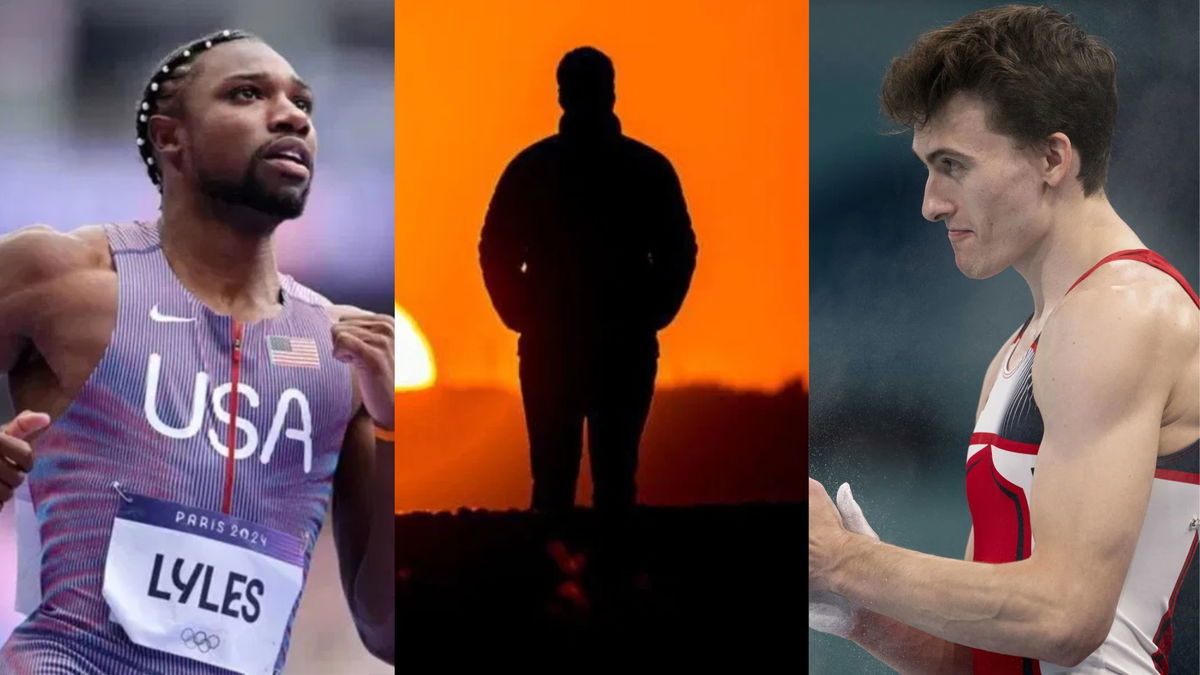
Imago
Noah Lyles and Stephen Nedoroscik (Image Credits: IMAGO)

Imago
Noah Lyles and Stephen Nedoroscik (Image Credits: IMAGO)
Long after Olympic champions Noah Lyles and Stephen Nedoroscik spoke out about the fragile state of men’s gymnastics in the United States, a new chapter has unfolded with an act of direct support. At a time when warnings about the sport’s decline were being met with concern but little action, one of America’s own gymnasts has intervened to provide tangible assistance.
Watch What’s Trending Now!
Lyles, who stunned many by showing up at Fred Richard’s gym following the Paris 2024 Olympics, revealed more than his athletic versatility that day. While his performance across four basic routines drew admiration, his real contribution was his decision to amplify the challenges facing the sport. On July 26, he reposted a message from James Jones, the founder of a low-cost gymnastics club in Atlanta, who disclosed that his facility, home to the only Black boys’ team in the nation, was about to lose its lease on August 1. Jones detailed how efforts to relocate had been blocked by zoning restrictions in Clayton County despite a basketball gym operating only yards away. His words were stark, “Anybody know of churches, school, anywhere we can use as a temporary location?”
The crisis that Jones described did not occur in isolation. Nedoroscik, an Olympic medalist on pommel horse, had already drawn national attention in October 2024 when he criticized Ohio State University’s decision to remove athletic scholarships for men’s gymnastics. The move came only months after Team USA had secured its first Olympic team medal since Beijing 2008. “Ohio State removing athletic scholarships from Men’s Gymnastics. Yet again, another step backwards for MGYM,” Nedoroscik wrote on X. On Josh Scherer’s program Mythical Kitchen, he underscored the broader trend, saying, “Since like the 1980s NCAA programs have been dropping, dropping, drop and drop. Even like recent days, like Ohio State just cut their scholarships.” In 1981, there were 59 Division I men’s gymnastics teams. Today, that number has diminished to just 12.
ADVERTISEMENT
Against this bleak backdrop, the turning point arrived when U.S. national team member Donnell Whittenburg stepped forward. Jones announced the news directly on X, “I’d like to thank national team member Donnell Whittenburg @D_whittenburg for his donation to our gymnastics team’s fundraiser for a new gym location.” Unlike calls for awareness, Whittenburg’s gesture provided immediate relief, offering the Atlanta program a chance to continue. His donation addressed the practical needs of a club that has faced institutional resistance since its founding in 2019, when College Park Georgia Athletics declined to allow boys to compete and Clayton County Parks and Recreation refused to sanction a program.
I’d like to thank national team member Donnell Whittenburg @D_whittenburg for his donation to our gymnastics team’s fundraiser for a new gym location. pic.twitter.com/5gIv2e9VFw
— James Jones (@jamesjonesesq) September 6, 2025
The donation highlights a broader question that has lingered for decades. That is ‘how to ensure the survival of men’s gymnastics in the United States.’ The sport has suffered from dwindling NCAA opportunities, the closure of regional clubs, and limited investment compared with other disciplines. Lyles’s decision to broadcast Jones’s appeal and Nedoroscik’s outspoken criticism of scholarship cuts illustrated how outsiders and insiders alike recognize the urgency. Whittenburg’s contribution, however, translated recognition into action.
ADVERTISEMENT
For the Atlanta boys who faced displacement only weeks ago, the outcome has shifted. Their gym now has a lifeline, and their future is not defined solely by policy failures or institutional neglect. The story also demonstrates how collective attention, when followed by decisive assistance, can preserve opportunities where statistics alone suggest decline. What began as a warning from athletes has become a small but significant step toward sustaining the sport. And James Jones built a men’s gymnastics academy to give Black boys opportunity, community, and a place to belong in a sport where they were rarely seen.
ADVERTISEMENT
James Jones’ academy reshaped men’s gymnastics for Black boys and now fights for its future
James Jones established the James Jones Gymnastics Academy in 2019 with a clear intention, to create access for young Black boys in a sport that had historically overlooked them. He often recalled that as a child he “didn’t see anyone who looked like me in this sport,” and that absence shaped his determination to build an institution where representation was not an exception but the foundation.

Imago
Credit: Instagram/ Donnell Whittenburg
The academy quickly became more than a training hall. While the boys learned handstands and tumbling, they also gained discipline, teamwork, and the confidence to pursue ambitions that stretched well beyond a balance beam or set of rings. More than six hundred boys passed through the doors, many of them training at little to no cost. For several, the program represented the first step toward collegiate scholarships or even the possibility of Olympic competition.
ADVERTISEMENT
The practical realities of the facility, however, revealed the limits of good intentions. The academy operated in a converted office space where the ceilings were so low that athletes occasionally struck them mid-routine. Jones located larger warehouse options that could accommodate proper training, yet zoning rules written for industrial use barred athletics in those buildings. As his lease approached its end, he was left searching for solutions to keep the academy alive.
Top Stories
J. J. McCarthy Awaits Punishment From Vikings After Rejecting Kevin O’Connell’s Instructions

Prayers Pour In as South Carolina HOFer QB Dies at 52

Patrick Mahomes Doesn’t Hold Back in Emotional Statement After Chiefs QB’s Troubling Knee Injury Update

Andy Reid Announces Patrick Mahomes’ Injury Diagnosis as Chiefs HC Doesn’t Hold Back After Playoffs Elimination

Dale Jr. Warns of Deeper Issues as Joe Gibbs Parts Ways With Decade-Long Executive

Chase Elliott’s Popularity Hits New Low as Dale Jr.’s Daytona 500 Return Triggers Record-Breaking Sale

One option emerged in South Fulton County, where a new building closer to Atlanta offered the necessary size but came with higher costs. To bridge the gap, Jones created a GoFundMe campaign. “We’ve found a building that is suitable for gymnastics,” the campaign explained, though it acknowledged that rental rates near the city carried a significant increase. Supporters responded with urgency, and by early September the effort had collected more than $48,000 of the $55,000 goal, including a notable contribution from Olympic gymnast Donnell Whittenburg.
ADVERTISEMENT
ADVERTISEMENT
ADVERTISEMENT

